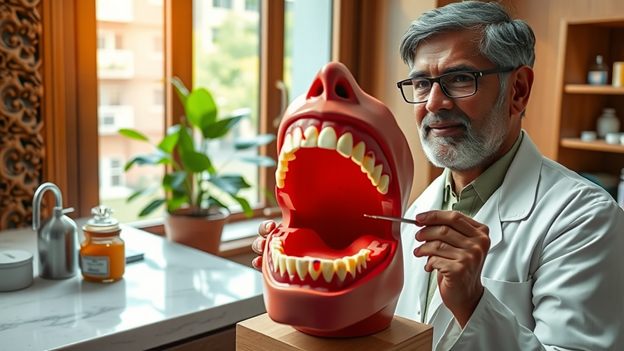Oral health is crucial for our overall well-being. Among the many oral issues, oral lesions often stand out. These lesions can affect anyone and understanding their origin is vital. Early detection is important because it can prevent complications down the road. Handling these lesions with care is essential, and knowing oral lesions treatment options helps in managing them effectively. From learning about their causes to recognizing symptoms, you can adopt better strategies to deal with these oral challenges.

What Are Oral Lesions?
Oral lesions refer to any abnormal change or damage occurring inside your mouth. They can appear as sores, bumps, or patches. It’s crucial to recognize these changes because they can indicate more serious conditions in some cases. By identifying different types of lesions, you’re better prepared to take action. Knowing what you’re dealing with helps in choosing the right oral lesions treatment options. This knowledge can guide you in making informed choices for your oral health.
Common Causes Leading to Oral Lesions
Understanding the different causes of oral lesions is key to effective management. These lesions can result from:
- Physical trauma: Biting your cheek or tongue, or any injury to the mouth.
- Infections: Bacteria, viruses, and fungi can all contribute, leading to sores or thrush.
- Autoimmune conditions: Diseases like lupus can affect the body’s ability to heal, causing sores.
- Nutritional deficiencies: Lack of crucial vitamins or minerals, such as vitamin B12 or iron, can lead to lesions.
- Allergic reactions: Some toothpaste or mouth rinses can irritate the mouth, causing lesions.
- Stress and hormonal changes: Both can disrupt the body’s balance and lead to mouth sores.
By recognizing these oral lesions causes and treatments, you can take steps for preventing oral lesions. It’s helpful to keep in mind:
- Maintain a well-balanced diet to avoid deficiencies.
- Use gentle dental products to avoid irritation.
- Manage stress through relaxation techniques like deep breathing.
These steps form a part of a proactive approach to oral health, keeping issues at bay before they start.
Types and Characteristics of Oral Lesions
There are many types of oral lesions, each with distinct features:
- Canker sores: Painful, small ulcers with a white base and red border, often inside the mouth.
- Cold sores: Blister-like lesions, typically on lips, caused by the herpes virus.
- Oral thrush: White patches inside the mouth, caused by an overgrowth of yeast.
Understanding these types is important when considering oral lesions treatment options. Each type may require a targeted approach to manage effectively. If you know the symptoms of oral lesions, it becomes easier to identify them early and prevent complications.
When is it Time to Visit a Healthcare Professional?
Monitoring symptoms of oral lesions helps decide when to see a doctor. Seek expert advice if:
- Lesions persist beyond two weeks.
- They become more painful or rapidly increase in size.
- Accompanied by a fever or sore throat.
Ignoring these signs might lead to other health problems. For safe and effective care, consult a healthcare provider for proper guidance.
Diagnosis: Getting to the Root of Oral Lesions
Proper oral lesions diagnosis is vital for effective treatment. Diagnosing these lesions often involves:
- Visual examination by a healthcare professional.
- Biopsy, where a small sample of tissue is tested.
These steps ensure accurate identification of causes of oral lesions. With a correct diagnosis, professionals can recommend effective oral lesions treatment options to address specific needs.
Treatment Options: Finding Effective Solutions for Oral Lesions
Treating oral lesions depends on their cause and severity. Here are some approaches:
- Self-care: Rinse with saltwater to soothe minor sores.
- Over-the-counter options: Look for topical gels or antiseptic mouthwashes.
- Prescription treatments: In severe cases, a doctor may prescribe medication.
Sometimes professional dental care is necessary. Dentists can suggest specific procedures that address stubborn lesions effectively. By exploring varied oral lesions treatment options, you can manage oral health problems conveniently.
Proactive Prevention: Keeping Oral Lesions at Bay
Preventing oral lesions involves good practices:
- Oral hygiene: Brush and floss regularly to keep your mouth clean.
- Balanced diet: Include foods rich in vitamins to avoid deficiencies.
- Stress management: Practice relaxation and sleep well to keep stress in check.
Regular dental check-ups allow professionals to spot potential issues early, guiding you in preventing oral lesions effectively. Commit to these preventive steps to protect your oral health.
Living with Recurrent Oral Lesions: Strategies for Adaptation
Sometimes, oral lesions can recur. It’s essential to find ways to adapt:
- Adjust your diet: Avoid spicy or acidic foods that may trigger lesions.
- Cool compresses: Soothe painful areas with cold packs.
- Seek support: Associate with groups sharing similar experiences for guidance and comfort.
These strategies help manage symptoms of oral lesions, making it easier to continue daily life without disruption.
Conclusion
Understanding oral lesions causes and treatments is crucial for maintaining good oral health. By identifying symptoms of oral lesions early, you can take essential steps to address them. Become proactive in taking care of your oral health, and consider regular visits to healthcare providers. Implement these strategies and enjoy a healthy, pain-free smile.


